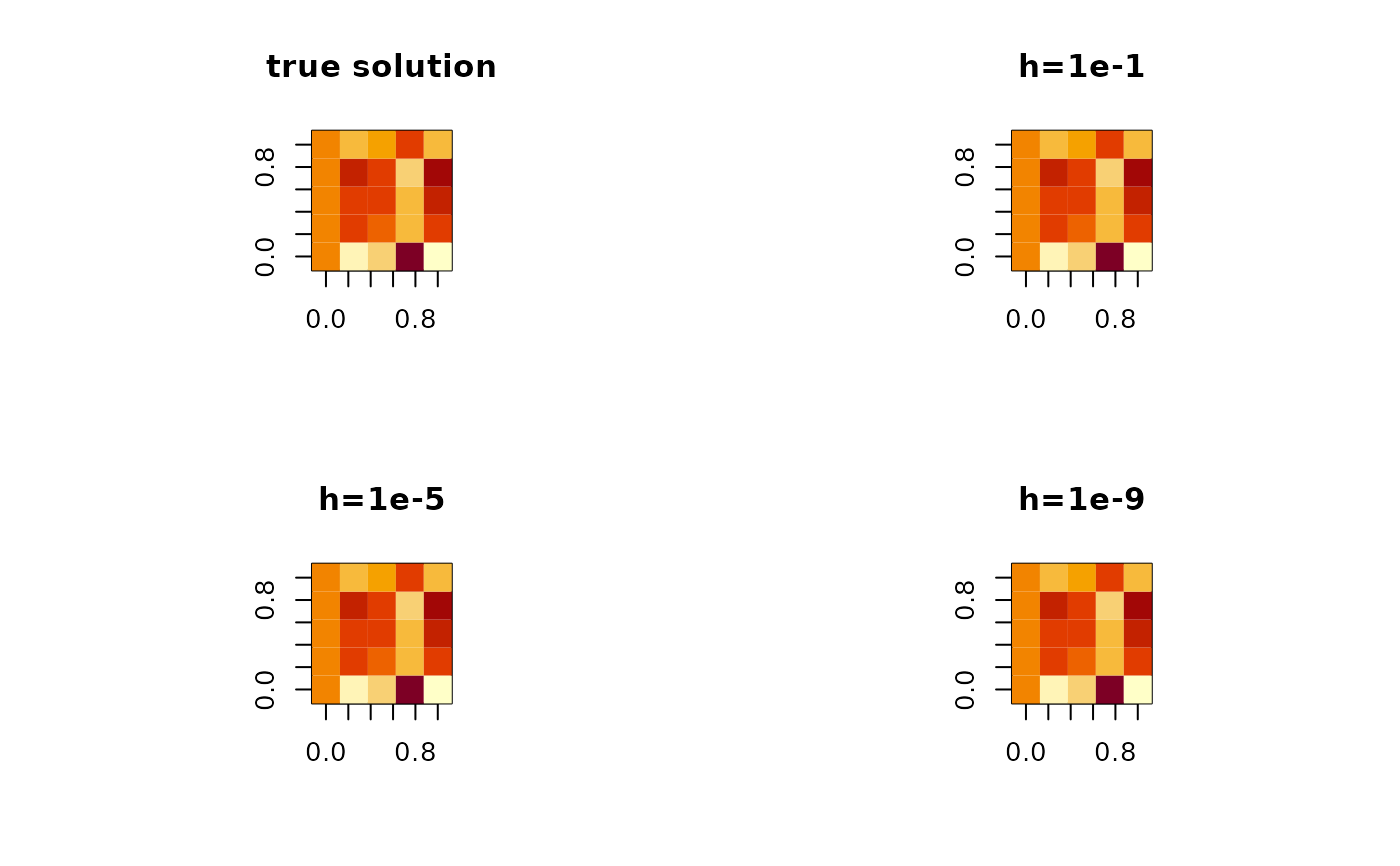Numerical Approximation to Gradient of a Function with Matrix Argument
Source:R/matderiv.R
matderiv.RdFor a given function \(f:\mathbf{R}^{n\times p} \rightarrow \mathbf{R}\), we use finite difference scheme that approximates a gradient at a given point \(x\). In Riemannian optimization, this can be used as a proxy for ambient gradient. Use with care since it may accumulate numerical error.
matderiv(fn, x, h = 0.001)Arguments
- fn
a function that takes a matrix of size \((n\times p)\) and returns a scalar value.
- x
an \((n\times p)\) matrix where the gradient is to be computed.
- h
step size for centered difference scheme.
Value
an approximate numerical gradient matrix of size \((n\times p)\).
References
Kincaid D, Cheney EW (2009). Numerical Analysis: Mathematics of Scientific Computing, number 2 in Pure and Applied Undergraduate Texts, 3. ed edition. American Mathematical Society, Providence, RI.
Examples
## function f(X) = <a,Xb> for two vectors 'a' and 'b'
# derivative w.r.t X is ab'
# take an example of (5x5) symmetric positive definite matrix
# problem settings
a <- rnorm(5)
b <- rnorm(5)
ftn <- function(X){
return(sum(as.vector(X%*%b)*a))
} # function to be taken derivative
myX <- matrix(rnorm(25),nrow=5) # point where derivative is evaluated
myX <- myX%*%t(myX)
# main computation
sol.true <- base::outer(a,b)
sol.num1 <- matderiv(ftn, myX, h=1e-1) # step size : 1e-1
sol.num2 <- matderiv(ftn, myX, h=1e-5) # 1e-3
sol.num3 <- matderiv(ftn, myX, h=1e-9) # 1e-5
## visualize/print the results
expar = par(no.readonly=TRUE)
par(mfrow=c(2,2),pty="s")
image(sol.true, main="true solution")
image(sol.num1, main="h=1e-1")
image(sol.num2, main="h=1e-5")
image(sol.num3, main="h=1e-9")
 par(expar)
# \donttest{
ntrue = norm(sol.true,"f")
cat('* Relative Errors in Frobenius Norm ')
#> * Relative Errors in Frobenius Norm
cat(paste("* h=1e-1 : ",norm(sol.true-sol.num1,"f")/ntrue,sep=""))
#> * h=1e-1 : 2.47435845237516e-15
cat(paste("* h=1e-5 : ",norm(sol.true-sol.num2,"f")/ntrue,sep=""))
#> * h=1e-5 : 2.35670523982772e-11
cat(paste("* h=1e-9 : ",norm(sol.true-sol.num3,"f")/ntrue,sep=""))
#> * h=1e-9 : 1.97572724360866e-08
# }
par(expar)
# \donttest{
ntrue = norm(sol.true,"f")
cat('* Relative Errors in Frobenius Norm ')
#> * Relative Errors in Frobenius Norm
cat(paste("* h=1e-1 : ",norm(sol.true-sol.num1,"f")/ntrue,sep=""))
#> * h=1e-1 : 2.47435845237516e-15
cat(paste("* h=1e-5 : ",norm(sol.true-sol.num2,"f")/ntrue,sep=""))
#> * h=1e-5 : 2.35670523982772e-11
cat(paste("* h=1e-9 : ",norm(sol.true-sol.num3,"f")/ntrue,sep=""))
#> * h=1e-9 : 1.97572724360866e-08
# }